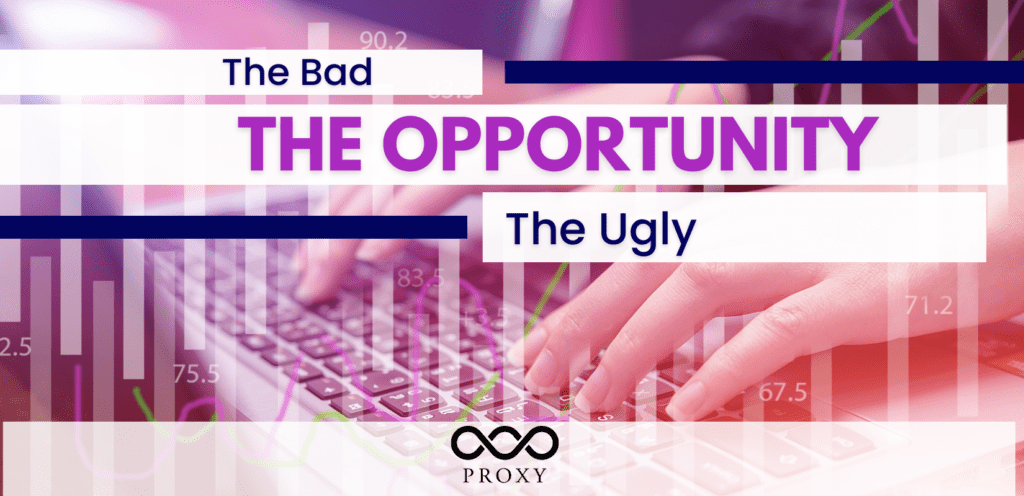In what was in no uncertain terms a very challenging year to be involved in traditional investments such as stocks and bonds, we at Proxy Financial were not immune from the markets which plagued 2022. Those of you who find yourself reading this, may also have seen our in depth 2022 market synapsis, 3Q2022 Commentary here, however I will recap what I believe to be the most significant drivers of performance for both our strategies at Proxy and the markets at large. Inflation, the fear of inflation, and the US Federal Reserve (the fed) were the biggest factors in the resulting bear markets of 2022. You may have been exposed to some of this through mainstream media, but we will go a bit deeper. 2020, and specifically COVID-19, brought the world to a halt – both socially and economically. The waves of stimulus which followed, along with the easing and overall loose monetary policies of virtually all governments and banks, allowed for a sharp recovery of the stock markets, housing markets, and most global economies. The pockets of consumers’ became flush with cash, saving accounts grew more robust than they had been in a decade, and with the world trending back to the (new) normal, people and companies spent. Despite the expected and incidental decreases in laborers (Retirees, turnovers, or those who were better suited on unemployment), the unemployment figures fell to historic lows. Most people who did return to the work force had new opportunities and the hiring booms across many industries allowed them to demand even higher salaries and benefits (notably in the white-collar sectors). Meanwhile, Vaccines were flying off the shelves, COVID was still running rampant, with infection rates skyrocketing, though now with a very low mortality rate, the media pivoted from COVID reporting and the general consensus of the public quickly followed until there were growing sentiments of returning to pre-covid conditions. People began traveling, making expensive home purchases utilizing rock bottom mortgage rates, overpaying for 2016 Honda CRVs, day trading crypto, NFTs, SPACs – life was good! So… what happened…? I don’t need to retell the myth of Icarus or quote the famous idiom for which it brought about, but hubris was involved and society at large ignored the warning signs and the increasing heat. Fast forward to 2022 which gave way to the combined compounding effects of strained supply chains (low availability of goods) with an increasing demand. The unfortunate reality remained that the world economies and general production were shut down almost completely for up until then, creating a very large conflict with the above mentioned supply and demand expectations. The cost of housing begun to correct the other way, with both home prices and rent being driven up by new demand and low inventory. Due to international conditions, the previously cheap gas prices quickly transitioned into the most expensive fuel costs and conditions in over a decade, with massive demand. The US domestic supply was significantly diminished by the necessary shuttering of many refineries. Higher fuel costs do not just effect your commute to work or the drive to the grocery store, but every step from production all the way through shipping and delivery. This was further compounded by our reliance on international goods and production partnerships, many of which fared the same if not worse than the US during the two years leading up to 2022. Additionally, Russia’s war in Ukraine added even more global economic pressures on supply chains, with the resulting sanctions heavily impacting the energy industry. All of these factors, combined with the spike in fuel costs, growing costs of used cars, housing, and food (the farming industry was not exempted and suffered rising costs of seed and fertilizer), directly lead to rapid inflation. Controlled inflation can be good as a necessary component of the economic cycle, but runaway inflation is trouble and needs to be monitored and manipulated in an effort to keep it in check. Needless to say, we were not prepared to tackle all of those conditions and in the summer of 2022, inflation hit a 40 year high at 8.6% YOY. The party that was 2021 was officially over. Enter the Fed. When simplified to its basic functions, the duty of the Federal Reserve is to conduct monetary policy with the goal of promoting and maintaining stability in the US economy. High inflation is a threat to that economic stability, and while there is more than one tool that the Fed could use to deal with the issue of inflation, adjusting the target rate, also known as the Fed fund rate, was the one they decided to utilize most heavily. The objective behind pushing up the Fed fund target is that borrowing money becomes more expensive and more difficult, slowing heightened investing, and allowing the supply chains to recover and bridge the gap between supply and demand. Throughout most of 2022, the Fed leaned hard on this approach, whether that was the best method or not, we saw the target rate leap from 0.25% at the end of 2021 to 4.5% at the close of 2022. Turning up the dial of he Fed Funds target is not meant to have immediate impacts on inflation, rather it takes time for the effects to cycle through the system. We as individuals and business owners have seen this in mortgage rates, credit cards, as well as both business and personal loans. Ultimately, in making money less accessible while the cost of just about everything else is heightened, households have less excess cash to spend, and businesses stop borrowing capital for growth and/or expansion. Profit margins are also likely to shrink, and the slowing economy often triggers layoffs and rising unemployment. The approach the Fed had taken may or may not drive a rescission, but either way inflation and the measures used to control it will have taken its toll on the general economic conditions. Heading into 2023 there remains a tremendous amount of uncertainty for the economy and the markets, but keep in mind that just because inflation may
What Happened: What we Did: What we are Watching: Disclaimer: Investing in financial markets carries risk, including loss of principal. You can lose some or all of the money that is invested. Past performance is no guarantee of future results. The material contained herein is for informational purposes only. This document does not constitute a recommendation of securities, securities portfolio, transactions or investment strategies. The projections were created based on hypothetical information, there is no guarantee that any of them will come true. Proxy Financial is a registered investment adviser. Proxy and its Financial Advisors are not licensed in all states to offer securities and insurance products. This site is not a solicitation of interest in any of these products or service in any state which the registered representative is not properly licenses.
What Happened: · The second quarter of 2022 ended, closing out the first half of the year with nearly all markets down in a significant way, many in a bear market territory. If you are a newer investor who just got into investing during the COVID craze, this is first time you are experiencing such a downturn. If you have been investing during the financial crisis or the “dotcom bubble”, you might recognize this feeling. However, with the S&P 500 down nearly 20%, you have never experienced anything like this first half of the calendar year, unless you were invested in 1970 (Proxy, however, was not even born yet). · With the S&P 500 down so much, was there a better place to be? From a broad market perspective, the answer is “not really”. The NASDAQ index closed the quarter at -29%, mid and small cap growth were down even more. Even Value which had help up the best was -12.87% to -17.24% ranging from large to small cap. Internationally, we were no better off, MSCI EAFE was -19.23% and MSCI EM was -17.57%. · Bonds, the usual safe haven from a poor equity market also failed us in this high inflation, raising rate world we now live. In the US the BARC Aggregate Bond Index was -10.29% & BARC High Yield Index was -14.19%. Outside of the United States was even worse, Non-UDS WGBI was -18.41. A year ago, the 10-year US treasury was at a rate of 1.47%, as of Jun 30, 2022, it was 3.01%. you don’t need a calculator to know that more than doubled. · Real Estate as represented by the FTSE Equity REITs index decreased -19.17%. Even gold ended the 2nd quarter in the red at -1.16%, as second quarter saw it give back 7.28%. The BBG Commodity Index, comprised most of Energy (~30% of index) and Grains (~22% of index) was one of the few bright spots for Alternatives posting a positive 18.5% on the year. · The next logical question is what happened to drive such a broad sell off across equities and fixed income, both domestic and aboard? To sum it up, Global Inflation. Economic measures of inflation have hit 40-year highs (8.6% YOY), caused by loose monetary policy, supply chain issues (both COVID & war related), and a strong demand for good supported by high levels of employment. · In this unique situation, the US Fed and other global central banks are being forced to take a very “hawkish” approach towards tightening monetary policies. Treasury Yield rose as much as 199bps from 1.51% to a high of 3.50%, while the national (30-year fixed-rate mortgage nearly doubled from the low 3% level towards 6%). Over the last three FOMC meetings, the Fed hiked the Fed Fund Rate (FFR) three times in increasing increments of 25bps (March), 50bps (May), and 75bps (June). To illustrate just how much this inflation has caught us all off guard, most markets were pricing in three to four 25bps FFR rate hikes for all of 2022. Perhaps Fed Chair Powell said it best when recently stated “I think we now understand better how little we understand about inflation.” · Some other central banks are acting as well. The Swiss National Bank surprised global markets with a 50bps rate hike the first hike in 15 years, Brazil’s central bank raised its lending rate by 50bps, and the Bank of England raised its rate by 25bps. However, there are still many other global central banks that catching up to do and will have to act fast. What we Did: · As illustrated above, there have been almost no safe places to hide in 2022, however there are actions we took to help limit the downside. Much of the action taken was either at the end of 2021 or very beginning of 2022, as we try to look ahead and be cautiously proactive, not reactive. · Examples of adjustments made are increasing out tactical cash position, increasing our gold exposure and utilizing TIPS in the Proxy Global Equity Portfolio. We also had shifted away more towards value and dividend paying companies, as well as minimizing Emerging Market exposure. Some of these tactical shifts have help to provide downside protect while others have provided any short-term benefits. Exposure to global semiconductor companies has been a detractor as well as an overweight to developed Europe in lieu of emerging markets. The net result of these shifts was positive, resulting in outperformance of about 230 bps YTD. · Some examples of what has worked increasing gold (IAU), Treasury Inflation Protected Securities, also known as TIPS (SCHP), Value/Dividend Companies (SCHD) as well as just simple cash. These 4 tactical shifts made up 18.5% of the portfolio allocation and were only down about 5.6% on average. As mentioned above, the biggest detractor was our Semiconductor (SMH), down -35% which we have increased to 3% of the allocation. While our Semiconductor play has underperformed the broad market YTD, it is a longer-term strategic play. We have also increased our direct exposure to this segment in our growth clients. Global demand for semiconductors remains high and while supply chain issue plague the sector, as they have so many facets of the economy, we see many of the top players in the space to be financially stable the upside in significant. The net result of these shifts was positive resulting in outperformance of about 230 bpts YTD. Global Equity was -17.7 vs the S&P 500 and MSCI ACWI which were both about – 20%. · While were able to make a shift towards value, away from tech and growth companies in our top-down Global portfolios, Proxy Growth strategy, because it is a style-pure portfolio, must remain focused on companies with higher than average long-term growth potential. Growth is, by nature, more volatile, and in the current environment, it has been even more so out of favor on Wall Street. In this current risk-off, high inflation environment we
The bad, the ugly and the opportunity By Marc DeCuffa, APMA® The year of 2022 has been another wild one for the Markets. While the previous three years had been marked with the fear and uncertainty of COVID-19 they were overall fantastic years for stocks. All major indexes were continuously hitting all-time highs, pushing valuations to extremes, all while making us feel like there was no end in sight. Now as we all move on from COVID-19, even though it is still lurking around the world, the economy is now facing the dire consequences of the very tools that saved the world from financial collapse during the pandemic. The loose monetary policy, rock bottom interest rates, real estate boom, increase in wages due to shortages laborers, etc. We are all also faced with the following realities: equity markets do go down from time to time, as do bond markets, “buying the dip” isn’t a fool-proof plan, and day trading crypto isn’t a sustainable “side hustle” or retirement strategy. What better way to illustrate this point then looking at HOOD (Robinhood Markets Inc.), which had everyone with a phone and stimulus check trading stocks and “shooting for the moon”. HOOD had its IPO the Summer of 2021, and hit the secondary market in the mid $30’s. As the embodiment of the momentum and uncheck optimism of its users, HOOD quickly shot up to $85! It also quickly dwindled downward along with the broad market. Almost a year and a bear market later, it’s trading near $7 at this moment. Quick math on that tells us it is trading down ~91% from its all-time high. So, why am I writing this? To shame investors of HOOD and make people feel bad? Not at all. If we are invested in this market, we all feel bad right now. HOOD is simply an example of the euphoria that has been brewing in the stock market over the past few years. So as the pendulum swings back towards its other extreme, pessimism and fear set it. Yet we must remember these emotions are in response to outside stimuli, things we, as individuals, have little to no control over. Now I can get into the chain of events that have brought us to the highest inflation seen since the 70’s, the Fed raising rates at clips last seen in 28 years, or how the NASDAQ is down over 31% at the moment; but those things might not even matter for your situation. At Proxy we like to focus more on the actions (or non-actions) we all can take to get us through these challenging times. First, take a quick moment to reassess your feelings during this market drop. These times are the true gauge of your risk tolerance. If you have thought of selling everything, if you are losing sleep over your investments or fear that you don’t have enough time to recover what has seemingly been lost, you took on too much risk. It’s easy to say we are aggressive when “risk assets” represent big upside, but when we are faced with the downside our real risk tolerance is revealed. If you are one of the many people now rethinking your risk tolerance: all is not lost. Especially if you have time on your side, since historically markets have been cyclical with their ups and downs. With our guidance and time, your recovery could be both quicker and less painful. On the other hand, if you took the down payment for your pending home purchase which was sitting safely in a savings account (probably earning nothing), and threw it all into QQQ (Nasdaq ETF), you might have to wait a while before your dreams of homeownership are a reality. You should also, at this point, seek out our team to help you avoid compounding the issue. Second, if you did everything “right”, as in, you understood the appropriate amount of risk you should be taking and were on track for your goals prior to this bump in the road, stay the course! If your goals and time horizons for investing have not changed, neither should your investments. Work with your Advisor at Proxy to make sure you are still properly positioned and if small adjustments should be made, that’s not a problem either. Just don’t let your emotions push you to make rash decisions. Don’t make decisions that will affect yourself and your family while “lizard brain” is in control. One of the most important jobs of your Advisor is to be the buffer between you and the eject button when your brain is in “fight or flight” mode. Our Advisors will not only work hard to put you on the right path to financial freedom but will also prevent you from unnecessarily undoing those years of hard work, saving, and discipline. Lastly, don’t look at this as all bad. The expression “making lemonade out of lemons” pops to mind. Maybe because it’s going to be 90 degrees today in NYC and lemonade sounds good. Or maybe because we can take the challenging, sour market we are in now and make the best out of it. If you are looking at big loses in your investment account or have no investments and fear getting into the market now; focus on the future. This might sound disconnected from your emotional pain from the losses in your portfolio. It’s not. We understand you and have talked with clients in these markets for decades. The lemonade to come from this will be yielded from the extreme sell off, one where many overpriced not so good companies are trading at all-time lows, but also many great companies with tremendous opportunity are trading at real discounts. Those great companies, that investors were willing to buy at all-time highs and at severely overpriced valuations, are now priced at relative discounts. Yet so many are afraid to jump on the deal. You don’t run away from a Black Friday sale, do
What Happened: · While March ended the month positive across all major US equity indexes, Q1 was still negative, more accurately representing the tone of 2022 so far. Many uncertainties in the economy and geopolitics shaped the year thus far, resulting in the YTD performance: S&P 500 at -4.6%, the DJIA -4.1%, NASDAQ -8.94% & MSCI EAFE -5.77%. These Q1 ending numbers reflect an improvement from the low point which saw the S&P down -12.5%, as an effect of inflation, raising rates and the Russian invasion of Ukraine, this last point further complicating an already upturned global supply chain. · Credit markets offered no shelter for those looking to escape the woes of the equity markets, as we witnessed short term yields spike, causing a brief inversion to the yield curve. Bonds prices across all sectors have been depressed as reflected by the Barclay Aggregate Bond Index, down over -5.9% on the year. March began the Fed’s campaign to combat inflation by raising the target range by 25 basis points. This hike from the Fed was the first of many, as it has signaled its intentions for six more rate hikes this year with four additional hikes in 2023. · Globally there was no place to hide. Inflation, the Russia-Ukraine war, supply chain limitations, and even resurgence of the infamous lockdowns (this time heavier in China) caused a strange “flight to safety” from market participants. What we Did: · Proxy’s portfolio management team made few changes in the month of March. The tactical adjustments made in the prior months showed to add safety and value to clients of all risk profiles. · The Growth portfolio, keeping true to its investment objective, continues to hold and look for new opportunities in companies with significant future earnings potential. Our overweight towards companies with stronger current earnings helped results, as investors fled from the growth theme. The portfolio’s significant exposure to Mid and Small cap companies has been an even greater detractor. For example, the Russell large cap growth indexes are down just over 9% YTD while Mid and Small growth cap indexes are both down more than 12.5% YTD. With our current overweight towards cash, we continued to seek opportunities with strong companies now trading at discounted prices. While we did not initiate any new positions in March, we deployed some of the cash reserves into companies that are now presenting much more reasonable price entry points. · The Proxy Global Equity strategy, while experiencing less volatility than the broad market, has not expected the global sell off. US equities, International developed and Emerging Markets have all been down on the year. We had adjusted the model with a lean towards value and global dividend paying companies as well as an increased position in gold via IAU. The shift away from EM was made last year, however the overweight towards developed Europe has become a detractor following the impacts of the Russian invasion of Ukraine and the economic disarray this has caused in continental Europe. · Proxy’s Value strategy, a Dividend Income portfolio, holding true to the “flight to safety” theme, ended the quarter with positive returns. Our exposure to energy and precious metals led the way in performance. The addition of TC Pipelines LP (TRP) and Wheaton Precious Metals (WPM) at the start of the year had proven to be a solid value. We had an annualized average yield of 3.6% and continue to seek out quality companies that will help sustain that level of income. What we are Watching: · The Fed and policy makers will have to deal with unprecedented times. The US is close to what’s called “full employment”, the global supply chain is still in a chaotic mess from the pandemic, inflation is partying like it’s the 80’s and a war that’s happening in continental Europe. · As the Fed continues to push rates in response to growing inflation, we will also closely be looking at the direct effects on the credit market as well equity markets. As short-term rates increase, the risk-free rate of return, as represented by US treasuries become more attractive. The continued market volatility, inflation and overall uncertainty may start to shift investors away of riskier investments and towards a more attractive “guaranteed rate”. · Russia’s invasion of Ukraine grinds on not only to the devastation of people of the Ukraine. With no clear end in sight and sanctions on Russia expanding, the Russian economy will be in serious distress. The surrounding European countries, including many of US’s large economic partners, dependent on Russian commodities, are also feeling the sting of this sense war. · As risk managers, we at Proxy will continue to look for opportunities which are often created in times of uncertainty. We will also continue to minimize risk whenever possible during these volatile times.
What Happened: · February markets started off the month with a bit of a bounce back from the hard hit we took during January, but January’s many concerns remained. And volatility persisted. The most defining moment came at the end of the month as Russia invaded Ukraine. U.S. markets in general took a large hit, with the S&P 500 down over 3% for the month and at roughly -8% for the year. · Growth equities continued to see the worst of it, while Value has fared relatively better, assisted by surging energy and commodities related companies. International Markets also took a hit, with the EAFE down roughly 1.8% and Emerging markets suffering worse around -3% for the month. · US bonds prices continued to fall during the month and with the aggregate down ~4% YTD. While treasuries and other high-quality debt has historically been safe place during such global turmoil, the Feds actions to hike rates has keep some downward pressure and the yield curve flat. Both the 5-year & 10-year treasury yields remained just below 2%. Emerging Market debt, largely driven by Russia, plummeted, down nearly 12% as of the end of the month. · The world response to the aggressive and deadly actions of Putin to invade Ukraine sparked significant sanctions against Russia. The anticipation going forward is that if sanctions on Russia continue for extended periods, not only will Russia’s economy continue to spiral downward (along with the Ruble), but much of Europe feel some negative impact as well. What we Did: · Proxy continued to keep focus on the longer term, especially since such geological events tend to have short lived impacts on financial markets. In this case, the current pressures on global supply chains will likely continue to grow the many sanctions and their impact, which can add more pressure to the highest inflation seen in 40 years. We did reduce some of our direct Emerging Market exposure in our Global Equity models. Even prior to Russia’s invasion of the Ukraine, we did not have a very positive outlook on Emerging Market. · Growth continued to be out of favor by the Market, as much of it is characterized by higher risk and promises of future earnings. When the present is nebulous, Wall Street has even less appetite to bet on the future. The Proxy Growth portfolio stuck to its discipline because short term volatility historically is compensated by long term focus. Our diversification into small and midcap growth which had been a detractor prior, seems had found some support and added positive returns. The recently downtrodden Large Cap. companies are now down approximately 12% on year. · Proxy also stayed the course within the value oriented, Dividend Income portfolio. We benefited from adjustments made at the end of 2021, as we leaned into energy and precious metals adding companies such as Newmont Corp and TC Energy Corp. These additions not only added to the outperformance of the S&P in 2022, but also boosted the 12-month yield to 3.7%. · Regarding fixed income, higher quality and lower duration have helped our performance in this difficult period for bonds. Rising rates will affect most any fixed income position, whether through mark-to-market volatility or decreasing face values. We made no changes and will continued to stay away from low credited quality and Emerging Markets. What we are Watching: · Like every person in the free world we keenly observing the war which Putin has brought on the people of Ukraine. Our hearts go out to the people of and in Ukraine. While there is no point in attempting to make sense of the actions of a mad man, we are focused on the spillover effect of the growing number of sanctions against Russia. So far, we don’t see a dire scenario that would warrant adjustment of financial plans and goals. Stay the course of your plan for now. As with anything in life, if matters escalate we will let our clients know. · Supply chain issues, record level inflation, Fed rate hikes and the end of its asset purchasing in March are also top of mind as we watch market volatility continue in this still young 2022. · Aspects of all this uncertainty may give the Fed some pause when it comes to how hawkish they might be with the initial rate hikes and maybe even the total number of increases. A more dovish approach should benefit the market. Overall, the US economy was healthy prior to Putin’s invasion. If spiked energy prices, increased supply chain issues and a hawkish Fed do all culminate into a recessionary environment, it will possibly be short and shallow. We are not overly concerned about a slowing economy because of the healthy employment market.
What Happened: What we Did: What we are Watching:
With everything in the world moving so quickly, we want to remind everyone to take a moment to ensure that we are being the best version of ourselves at all times. Proxy is implementing monthly book recommendations to help motivate our clients and advisors to put their best foot forward in everything they do. The first book we are tapping into is “Good In a Room” by Stephanie Palmer. This book provides a lot of key tips that are essential to help make better connections and develop more meaningful relationships. For example, when in a meeting the way you speak is just as important as the things that you say. Stephanie states that you should pitch yourself as if it were a first kiss – “flirt with small information and gauge interest based on what you hear.” This can help make anyone more interested in the conversation and leaves room for others to throw some ideas down on the table. Stephanie really hammers the nail on the head when it comes to focus, material and asking questions. She presses, “listen to your client like they have 20 minutes to tell you where the treasure lies.” Listening allows you to properly adhere to the conversation, process accurate information, and leave room for questions. A great tip she gives is “don’t ask ‘why?’’ and insists that using “tell me more” is a great way to encourage further detail. This process of listening and asking questions can also help build greater rapport with not only your clients, but people in your day to day life. Preparing your material is another huge step in becoming good in a room. “Failing to prepare is preparing to fail.” Do the research, set-up a strategy and show the commitment that was put in. Once you are fully prepared, it is important to remember to stay in sync within the conversation. What this means is that you must mirror the same pace, depth and tone of the client. It is a subtle reminder that they are the spotlight. When the flow is there, it can lead to a deeper relationship with the client. However, there are ways to fracture the conversation as well. Any fracture can easily be prevented by remaining professional and avoiding any common nuances as that will set you apart from competitor advisors. Stephanie encourages the reader by stating, “Don’t ask, ‘Am I right?’” This takes away from the client. She also lets the reader know that giving their opinion on an idea or telling the client their opinion is a big thing to stray away from. The whole point of this is that the client is the most important – this is not about you. All in all, there were a lot of important takeaways from “Good in a Room.” The advice mentioned within this book is easy to understand, and apply to your work or daily life. “Good in a Room” – Stephanie Palmer Disclaimer: Investing in financial markets carries risk, including loss of principal. You can lose some or all of the money that is invested. Past performance is no guarantee of future results. The material contained herein is for informational purposes only. This document does not constitute a recommendation of securities, securities portfolio, transactions or investment strategies. The projections were created based on hypothetical information, there is no guarantee that any of them will come true. Proxy Financial is a registered investment adviser. Proxy and its Financial Advisors are not licensed in all states to offer securities and insurance products. This site is not a solicitation of interest in any of these products or services in any state in which the registered representative is not properly licensed.
What Happened: What we Did: What we are Watching: Disclaimer: Investing in financial markets carries risk, including loss of principal. You can lose some or all of the money that is invested. Past performance is no guarantee of future results. The material contained herein is for informational purposes only. This document does not constitute a recommendation of securities, securities portfolio, transactions or investment strategies. The projections were created based on hypothetical information, there is no guarantee that any of them will come true. Proxy Financial is a registered investment adviser. Proxy and its Financial Advisors are not licensed in all states to offer securities and insurance products. This site is not a solicitation of interest in any of these products or service in any state which the registered representative is not properly licenses.
What Happened: What we Did: What we are Watching:

















